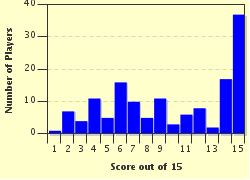Quiz Answer Key and Fun Facts
1. 'A silver shield, its field decorated with three smaller shield-shaped objects coloured red'... Using the correct language, how should these arms be described?
2. As well as a number of colours, or tinctures, heraldry also uses representations of two types of animal furs, these being known as ermine and vair. What part of the living animal do the dots on ermine represent?
3. The features of a shield of arms are described in a very specific order. What is always the first feature described?
4. In an uncoloured drawing or representation of arms, different metals and colours are shown as a system of dots and hatching, a method that was introduced during the 17th Century. What is the name given to these sketched drawings?
5. This charge, one of the simplest forms of decoration, is formed by two horizontal lines that contain the central region of the shield. Normally occupying one third of the area of the shield, what is this ordinary known as?
6. This ordinary is formed by two vertical lines that enclose the central area of the shield. By what name is this ordinary known?
7. Another ordinary, this area of the shield is contained within two diagonal lines that run from the dexter chief across the shield to its sinister base (remember that left and right in heraldry are taken from the viewpoint of the person behind the shield). By what name is this ordinary known?
8. A widely used ordinary, primarily because of its religious connotation was a form of cross known as the saltire. There are two saltires that appear on the union flag of Great Britain. Which two saints do these saltires represent?
9. Unless blazoned as reversed, how would you expect to see a chevron represented on a shield of arms?
10. The Royal Arms of Great Britain as we see them today are the culmination of centuries of development. During the reign of which English monarch are these arms considered to have originated?
11. In the UK, the flag seen flying over any building in which the current monarch is in residence is correctly known as the Royal Standard?
12. The motto "Nation shall speak peace unto nation" appears on the arms of which corporate body of the United Kingdom?
13. In heraldic terms, where would you be more likely to expect to see a small flag known as a pennon flown?
14. Branches, sprigs and leaves of trees and plants are commonly seen as heraldic charges. Represented on the effigy of Richard II in Westminster Abbey are the leaves, flowers and seed pods of 'Planta genista', the badge from which a dynasty of kings took their name. Which dynasty was this?
15. Azure, between three open crowns or an open book proper, leathered gules, garnished and having on the dexter side seven seals gold, and inscribed with the words DOMINUS ILLUMINATIO MEA. To which important and ancient educational body does this blazon refer?
Source: Author
SisterSeagull
This quiz was reviewed by FunTrivia editor
stedman before going online.
Any errors found in FunTrivia content are routinely corrected through our feedback system.


